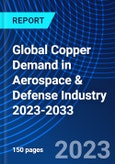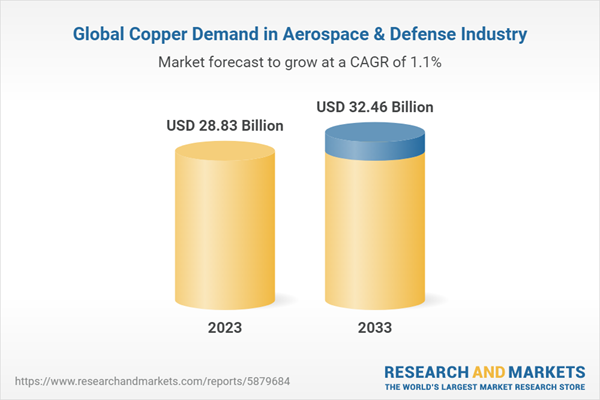Copper components are extensively used in both the aerospace and defense industries due to their exceptional electrical conductivity, thermal properties, and corrosion resistance. These properties make copper and its alloys ideal for various critical applications that require reliable performance and durability.The Demand for Copper Components in the Aerospace and Defense Industries is Influenced by the Development and Modernization of Aircraft, Military Vehicles, and Defense Systems
In the aerospace sector, copper's high electrical conductivity makes it a preferred choice for electrical wiring and connectors in aircraft, spacecraft, and defense systems. It ensures efficient transfer of electrical signals and power, ensuring smooth communication and power distribution within electronic systems.
Copper-nickel alloys, commonly known as cupronickel, are commonly used in heat exchangers and cooling systems in aircraft engines and propulsion systems. The high thermal conductivity of copper aids in dissipating heat effectively, maintaining optimal operating temperatures in these systems.
Radio frequency (RF) and microwave components, such as antennas, waveguides, and coaxial cables, in aerospace and defense systems utilize copper due to its low signal loss and good transmission properties. Copper's ability to conduct signals effectively is crucial for communication and radar systems in these industries.
Electro-mechanical systems, including actuators, solenoids, and motors, also make use of copper components due to their conductivity and magnetic properties. These components are vital for various mechanical operations in aerospace and defense systems.
Certain structural components in aircraft and defense equipment require high strength and wear resistance, which is achieved by using copper alloys like beryllium copper. These components play critical roles in ensuring the structural integrity and performance of these systems.
Printed circuit boards (PCBs) in aerospace and defense electronics are fundamental parts of electronic systems. Copper traces on PCBs allow for efficient signal transmission and power distribution, contributing to the reliable functioning of electronic devices.
Copper-based bearings and bushings are utilized in aerospace and defense applications that demand low friction and wear resistance. These components help reduce mechanical friction and extend the life of moving parts, ensuring smooth operation and increased longevity.
Certain types of munitions and ammunition casings also employ copper alloys due to their high machinability and ballistics performance. These copper components are vital for reliable and efficient ammunition production.
Copper alloys, such as phosphor bronze, aluminum bronze, silicon bronze, copper-chromium alloys, copper-zirconium alloys, and copper-tungsten, offer a range of properties suitable for various aerospace and defense applications. These alloys are chosen based on their unique characteristics, such as corrosion resistance, wear resistance, strength, and thermal conductivity.
Copper-nickel alloys, like C70600 (90-10) and C71500 (70-30), are essential for marine environments in defense applications. They provide outstanding corrosion resistance, making them suitable for naval vessels, submarines, and offshore platforms. In aerospace, these alloys are used in cooling systems that encounter harsh environments.
Phosphor bronze is valued for its mechanical properties, wear resistance, and fatigue strength, making it suitable for bushings, bearings, and springs in aerospace and defense.
Aluminum bronze is highly regarded for its high strength, wear resistance, and corrosion resistance, making it ideal for aircraft landing gear and structural parts in aerospace and high-load components in naval vessels and armored vehicles in defense.
Silicon bronze is known for its exceptional corrosion resistance and malleability, making it suitable for fasteners, springs, and connectors in both aerospace and defense.
Copper-chromium alloys offer high strength, excellent thermal conductivity, and wear resistance, making them valuable for aerospace electrodes, resistance welding components, and electrical connectors.
Copper-zirconium alloys offer enhanced strength, hardness, and resistance to softening at elevated temperatures, making them ideal for aerospace applications experiencing high mechanical stresses and thermal cycling.
Copper-tungsten alloys combine the excellent thermal and electrical conductivity of copper with the high melting point and hardness of tungsten. They find applications in aerospace electrical contacts, rocket nozzles, and electrical discharge machining (EDM) electrodes.
The market for copper components in aerospace and defense is driven by factors such as modernization efforts, material compatibility, ease of machining, miniaturization trends, and the adoption of additive manufacturing techniques. As the aerospace and defense industries continue to evolve and incorporate new technologies, the demand for copper components is expected to grow.
Recent developments in the industry include joint development projects between India and France for combat aircraft engines and the first flight of China's Chengdu J-20 fighter equipped with domestically produced WS-15 engines.
Overall, copper components continue to be indispensable in aerospace and defense applications, providing essential properties that contribute to the reliability, durability, and performance of critical systems in these industries.
Table of Contents
Table Information
| Report Attribute | Details |
|---|---|
| No. of Pages | 150 |
| Published | September 2023 |
| Forecast Period | 2023 - 2033 |
| Estimated Market Value ( USD | $ 28.83 Billion |
| Forecasted Market Value ( USD | $ 32.46 Billion |
| Compound Annual Growth Rate | 1.0% |
| Regions Covered | Global |









